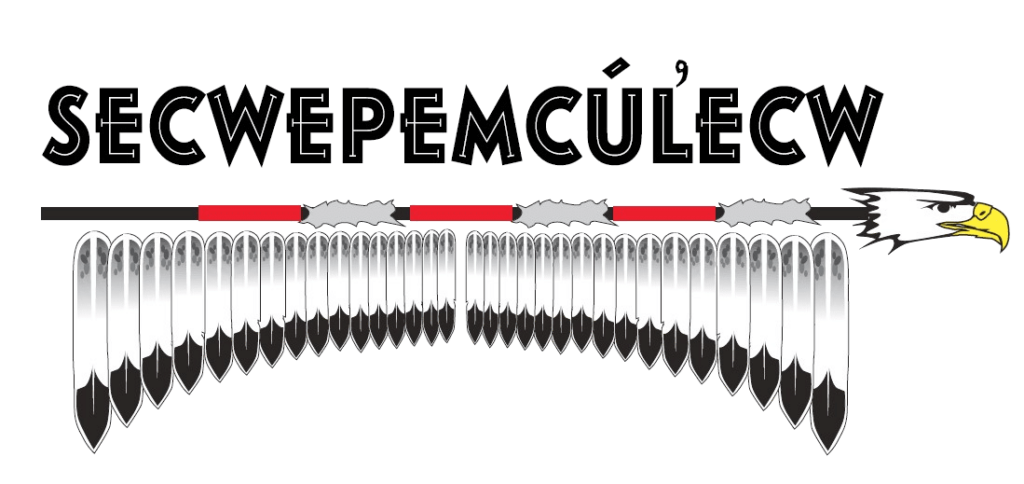
The name Secwépemc means “the spread-out people” (Ignace & Ignace, 2017) and describes the people who have for at minimum 10,000 years lived within the south-central Interior of what became known as the Colony of British Columbia in the late 1850’s. The territory of the Secwépemc people is called Secwépemc’ulecw and stretches approximately 145,000 square kilometers, originally including within it thirty-two recognized communities that have been categorized into 17 bands through the Indian Act and as a result of colonization. To this day, this large geographical land mass remains unceded, which means that the Secwépemc people never legally gave or signed away any right to their land.
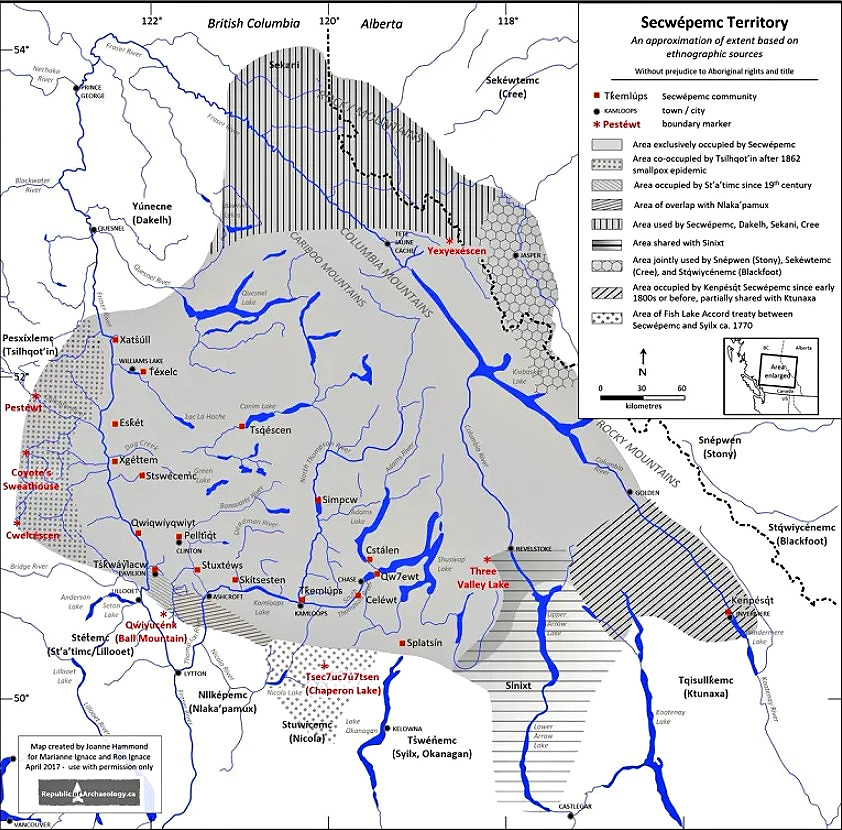
Thompson Rivers University operates two campuses within Secwépemc’ulecw, one on the traditional lands of the Tk’emlúps te Secwépemc (Kamloops campus) and the other at T’exelc (Williams Lake campus).
Before we move on, please take a moment to listen to this beautiful welcome song sung by Brenda Celesta of Secwépemc Nation, with images shown of some areas within Secwépemc territory.
Action Item
Before we move forward, please take a moment to click the link below and listen to the correct pronunciation of each of these communities names that has so graciously been provided by community members.
Secwépemc Community Members Own Words
Please take some time to listen to the following videos, as they are created by Secwépemc community members and discuss important issues relating to history, language, culture and land.
Elder Louis Thomas speaks about Secwépemc Nation:
Language, land and culture of the Secwépemc people created by Valarie Johnson of Esketemc:
Secwepemc Songs and Drumming
Setetkwe (Water song) by Tara Willard
Animal Song sung by Floyd Dick
Secwépemc Unity Song & Honour Song sung by Julianne Walshaw and Sonny Prairie Chicken
These above songs are only a small example as to the beautiful songs sung by Secwépemc people, and are meant to give learners an insight into the musical culture alive within Secwépemc’ulecw.
Secwepemctsín
The traditional language of the Secwépemc people is called Secwepemctsín, which has three distinct dialects: Northern, Eastern, Western. Prior to colonization, all members of the Secwépemc Nation, and many neighboring Nations, spoke this language fluently and often spoke more than one dialect.
Secwepemctsín contains within it invaluable ecological, cultural and historical knowledge of the Secwépemc people, including values, beliefs, social and political structures, spirituality and stories describing moral lessons. This language is inextricably linked to the land, and contained the teachings that were necessary to maintain Secwépemc culture and identity.
This language was traditionally passed down to the next generations orally, but due to the compound effects of colonial policies and institutions, Secwepemctsín is now classified as an endangered language with less than 200 fluent speakers, with the majority being over 65 years old (Dunlop et al, 2018).
Please listen to Elder Louis Thomas speak briefly about Secwepemctsín:
Action Item
Take a few moments to click the icons in the below image to hear a few Secwepemctsín words in the eastern dialect. Each word has a link that will take you directly to the First Voices website where you can hear speakers pronounce the words.
If you are currently residing in Secwépemc’ulecw, as a sign of respect and in effort to build better relationships with the original people of this land please take some time to explore the resources below that will help guide you in learning some introductory greetings that you can incorporate into your personal and work spaces.
- Learn Secwepemctsín Online through TRU
- First Voices – Learn Secwepemctsín
- Tk̓emlúpsemc re Secwepemctsín 1 – A Beginning Course in Secwépemc Salish – Western Dialect
- Secwepemctsin (Secwepemc Language) – Research Guides – TRU
Resources for Further Learning:
There are multiple fantastic resources available created by members of the Secwépemc community in partnership with TRU and other organizations that are designed to discuss Secwépemc culture, knowledge, language and history. Below are some examples for further learning about Secwépemc Nation; these examples do not represent all material available and do not substitute building genuine connection with Secwépemc community members to cultivate true reciprocal learning, but are a beginning step in this learning process.

Secwépemc Jurisdiction, Laws, and Governance
This website provided by Secwépemc Strong provides a detailed discussion into Secwépemc governance, laws, jurisdiction and nation building. This resource also discusses land stewarding practices, health and longevity of the nation, nation based child and family services as well as up to date information on gatherings.
To visit this resource please click here
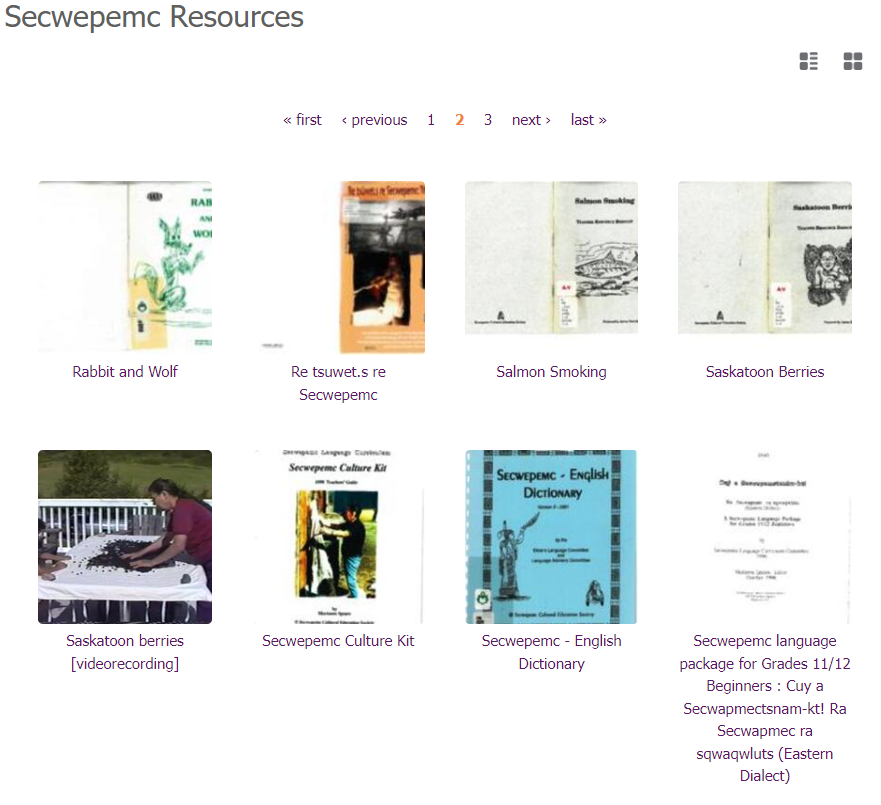
TRU Space Secwépemc Resources
This website holds an assortment of scanned resources including books, documents, printed manuals and stories from Secwépemc Nation. Within this resource are also videos, audio language learning tools and historical documents provided by the Secwepemc Cultural Education Society
To visit this resource please click here
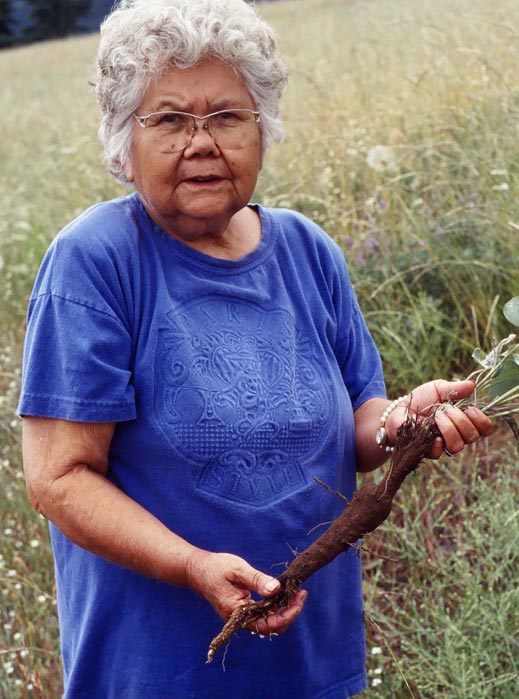
The Secwepemc Use of Wild Plants
Dr. Mary Thomas who is an Elder from Neskonlith discusses some plants that have been traditionally used by Secwépemc people, and shares lessons regarding the gathering of wild plants.
To read this article click here
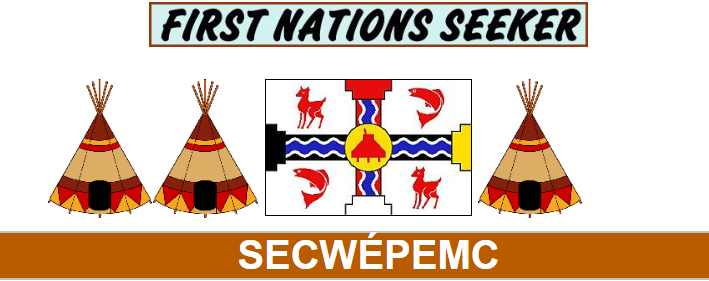
First Nations Seeker
This website helpfully compiled the websites of all Secwépemc bands into one place, as well as neighbouring Nlaka’pamux, Okanagan and St’at’imc bands who share close direct ties with Secwépemc Nation. Within this resource you can explore each bands website and learn more about individual Secwépemc communities.
To visit this resource please click here

Wel Me7 Yews Network for Indigenizing Higher Education at TRU
In 2018, Secwépemc Elder Mike Arnouse, of the Adams Lake Indian Band, gifted the Network the name Wel Me7 Yews which means “The Way It’s Always Been” to reflect the many people who come together to guide the work of a diverse network of Indigenous and non-Indigenous Advisory Council members.
Within this resource you can find videos showcasing the virtual Indigenous speakers series, the Secwépemc calendar and pronunciations, Oral traditions and Storywork, as well as all ongoing collaborations between TRU and members of Secwépemc Nation.
To visit this website please click here

Secwépemc Life Newsletter
This wonderful monthly newsletter is published from Chase, and showcases Secwépemc entrepreneurs, arts, culture, language and more. Their mission statement is to share stories, resources and opportunities in free online content to support Secwépemc Nation and Secwépemc success.
To visit this resource please click here
As mentioned above, these resources do not represent the entirety of Secwépemc culture and relevant teachings, but are an introduction to the various ways in which Secwépemc culture, language and education are available online to learn more about.
Concluding Thoughts
Now that you have a preliminary understanding as to who the Secwépemc people are and resources to begin a deeper understanding into Secwépemc values, culture and language, let’s take a look at Secwépemc Nations research ethics and guidelines.
